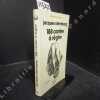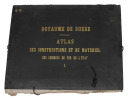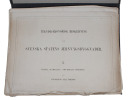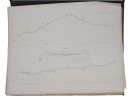-
Type
Book (3241)
Magazine (7)
-
Latest
Last 3 days (2)
Last month (17)
Last week (5)
-
Century
16th (2)
17th (6)
18th (97)
19th (558)
20th (908)
21st (102)
-
Countries
Belgium (448)
Denmark (686)
France (1063)
Italy (819)
Switzerland (232)
-
Syndicate
ILAB (2218)
NVVA (23)
SLACES (23)
SLAM (558)
THE BOOK OF THE FARM.
Blackwood, London, 1855. In-8 gr. (mm. 241x155), 2 volumi, mz. pelle edit. (un dorso restaur. per manc. al bordo super.), decoraz. oro di carattere naturalistico al dorso e al piatto, pp. XV,VIII,674; XII,804; testo su due colonne, con un ricco apparato iconografico di 589 incisioni su legno nel t. e 14 belle tavv. inc. in acciaio f.t., che raffigurano gli animali domestici della fattoria: cavalli, mucche, pecore, ecc. Seconda edizione. Solo qualche fiorit., altrimenti esempl. ben conservato.
Leben Georg Stephensons. Nach dem Englischen des Samuel Smiles.
Leipzig, Lorck, 1858. 8°. (1) VI, 126 S., (2) S. (Anzeigen). Halbleinenband der Zeit mit goldgepr. Rückentitel (berieben und bestossen). = "Carl B. Lorck's Eisenbahnbücher", Bd. 30.
Verbunden: S. III-VI nach S. 16 eingebunden. Durchgehend gebräunt und teilw. leicht stockfleckig.
188 contes à régler
1988 Editions Denoël, Collection "Présence du Futur", n° 474 - 1988 - In-12, broché, couverture illustrée - 351 p. - Illustrations de Roland Topor en N&B hors-texte
Bon état - Légers plis et frottements sur la couverture
Die Illumination der Leuchtthürme. Eine beschreibung des Holophotal-Systems, der azimuthal-verdichtenden und anderer neuer Formen von Leuchtthurm-Apparaten. Nach der zweiten Auflage des englischen Originals bearbeitet.. ergänzt von Chr. Nehls. Mit 16 ...
Leipzig, Baumgärtner, 1885. Contemp. hcloth. Orig. printed wrappers on the boards. XV,248 pp., 16 folded lithographed plates.
Economie de l'hypermatériel et psychopouvoir - Entretiens avec Philippe Petit et Vincent Bontems.
[s.l, Paris], Mille et une Nuits, 2008 1 volume 12,8 x 20cm Encollé sous couverture à rabats. 130p., 7 feuillets. Volume propre mais légèrement incurvé; pli légèrement marqué au dos.
Recueil de 2 entretiens du philosophe Bernard STIEGLER (1952-2020) avec Philippe PETIT, "A propos de l'économie libidinale capitaliste" et "A propos de la science contemporaine", et d'un entretien de Bernard STIEGLER avec Vincent BONTEMS, "A propos de l'hypermatériel"; précédés d'un texte de Philippe PETIT, "Le Pari de la sublimation", sur la pensée du philosophe. Où l'auteur formule "les enjeux des technologies culturelles et cognitives, mais aussi des biotechnologies et des nanotechnologies. Elles ne vont pas sans péril pour l'humanité, pour le "devenir non inhumain" de l'espèce humaine [...] Demain, l'homme sera-t-il désemparé de lui-même, de sa conscience et de sa libido, ou saura-t-il exister avec les technologies de l'hypermatériel ?" (4è de couverture).
"STODART, J. (JAMES) and FARADAY, M. (MICHAEL). - A PIONEER WORK IN CHEMICAL TECHNOLOGY.
Reference : 43118
(1922)
On the Alloys of steel. Read March 21, 1822.
(London, W. Nicol, 1922). 4to. No wrappers as extracted from ""Philosophical Transactions"" 1822 - Part II. Pp. 273-270. Clean and fine.
First appearance of a founding paper in the science of alloys.""Beyond his work in analytical and pure chemistry, Faraday showed himself to be a pioneer in the application of chemistry to problems of technology. In 1818, together with James Stodart, a cutler, he began a series of experiments on the alloys of steel. Although he was able to produce alloys of superior quality, they were not capable of commercial production because they required the use of such rare metals as platinum, rhodium, and silver. Nevertheless, Faraday demonstrated that the increasingly urgent problem of producing higher-grade steel could be attacked by science. The later work on steel of Henry Sorby, Henry Bessemer, and Robert A. Hadfield was based directly on Faraday's work in the early part of the century.""(DSB IV, p. 531-532).
L'ILIADE BREMBANA.
Ossia difesa del progetto adottato dal Consiglio Comunale di Milano per l'introduzione dell'acqua potabile. Con vedute generali sulla pubblica utlit di simili intraprese. Agnelli, Milano, 1883. In-16 gr., bross. orig., pp. VII,114,(6). Naturale dispersione dell'acqua corrente per evaporazione - Dispersione per assorbimento - Vantaggi indiretti che pu recare il progetto alla provincia di Bergamo... "Prima edizione". Cfr. Cat. Hoepli,942. Con timbri di appartenenza, altrimenti ben conservato.
Atlas von LXXVIII Platen, behoorende bij de Handleiding tot Kennis der Waterbouwkunde.
Te Breda, 1845. Folio. Cont.hcalf. Back worn. Plates fine. Containing 78 fine lithogr. plates. Description of the illustr. in small folio, 12 pp.
Cerveaux sans âme : les robots.
Paris, Editions et Publications Self, 1952. 14 x 22, 341 pp., illustrations N/B, broché, non coupé, bon état.
APPARECCHIATURA DEI TESSUTI DI LANA.
Trattato teorico - pratico ad uso degli industriali lanieri, direttori di lanificio, capi-apparecchio ed allievi delle scuole professionali. Hoepli, Milano, 1914. In-24 gr., cartonato editoriale, pp. XXIII,618 + 64 di Elenco Manuali, con 404 incisioni nel t. Prima edizione. Ben conservato.
The Naval Dry Docks of the United States. Illustrated with Twenty-Four fine Engravings on Steel. (2 Parts). Second Edition.
New York, Charles B. Norton, 1852. Large 4to. (33x27 cm.). Orig. full calf. Profusely gilt on spine and covers. Inside gilt borders. All edges gilt. Some wear to spine and lacks 2 cm. of leather at top of spine. Both covers detached. (4),113,83 pp. + 14 pp. of announcements. With all 24 engraved plates under tissue-guards. Some brownspots throughout and a leaf with some foxing. The plates in general fine with some brownspots, mainly marginal.
The first part deals with Granite Dry Docks, the second with Floating Dry Docks. ""The smaller number of pages in the second edition is caused by the printing of the descriptions of the plates on both sides of the leaves, whereas they appear only on the recto in the first edition."" (Sabin, 93148).
Histoire descriptive de la Machine à Vapeur, traduite de l'anglais de R. Stuart, précédé d'une introduction exposant la théorie des vapeurs;...
Paris, Mahler et Compagnie, 1827. 110 X 180 mm. broché, couverture d'origine grise imprimée, non rogné. XI-382 pp. suivies de 6 planches dépliantes. Edition originale de la traduction française. Quelques rousseurs.
Phone number : 41 021 964 60 10
100 JAAR MARGARINE 1869 - 1969.
, 's - Gravenhage, Martinus Nijhoff, 1969., Gebonden in linnen, goudopdruk op de rug, originele omslagwikkel, 16x24,5cm, 353pp, geillustreerd, goede staat.
Bij boek is er naar gestreefd een beeld te geven van de weg die het produkt aflegt van grondstof tot consument. Er wordt speciaal aandacht gegeven aan de ontwikkeling van de technologie, de ontwikkeling van het wetenschappelijk onderzoek, de ontwikkeling van het product, de expansie van de markt en het overheidsingrijpen.
Ingeniör Lexikon.
Stockholm, Carl Délen, 1805. Lille 8vo. Samtidigt hldrbd. Rygforgyldning. Lille papirsetiket påsat nederst på ryg. Stempel på titelbladet. (6),(4 = Prenumeranter),602,(2) pp. Tilskrift i blæk på foden af 1 blad. De første 10 blade med en svag skjold, ellers ren og velbevaret.
Ingeniör Lexikon.
Stockholm, Carl Délen, 1805. Lidt senere hldrbd. Rygforgyldning. Forgyldt rygtitel. (4 incl. subskribentliste),602,(2) pp, 12 kobberstukne foldeplancher. Et blad (pp. 527/28) i samtidig afskrift. På skrivepapir.
S.M.G.=Bilderbuch. Von einem M.G.=Offizier.
Berlin, ""Offene Worte"", 1931. Small 8vo-oblong. Orig. printed wrappers. (150),VI pp. With 72 full-page photographic illustrations of instructions on German SMGs.
Éléments d'électricité : à L'usage Des Candidats aux Emplois D'agent Des Installations Des P.T.T. Et Du Personnel D'éxécution Des Services Techniques
Paris Eyrolles 1961 Grand In 8 Collection " Cours professionnels des P.T.T. " Très complet , illustré de nombreux schémas . - 302 p. , 550 gr.
Couverture souple Très Bon État .
The architecture of Richard Rogers
Couverture rigide Wordsearch 1994 London 30,5x24 cm
Reliure d'éditeur pleine toile noire, titre au dos, jaquette illustrée en couleur - 159 pp. Nombreux dessins et illustrations en noir et en couleur. Bel état.
SUDRE René, BINET Léon, LEPRINCE-RINGUET Louis, DARRIEUS Georges, et alii
Reference : 80331
"Almanach des sciences, 1951; toute l'année scientifique."
Paris, Pierre Horay, Editions de Flore, 1950. 15 x 19, 255 pp., broché + jaquette, bon état (jaquette défraîchie).
La protection contre les rayonnements non ionisants. 2ème édition, Organisation mondiale de la santé, Publications régionales Série européenne No 25,
Copenhague, Organisation mondiale de la santé, 1991, in-8vo, XVI + 410 p., brochure originale.

(SLACES, NVVA)
Phone number : 41 (0)26 3223808
Levées des Villages à la Planchette (Survey of villages on a map-board).
France (Paris ?), Undated, around 1770. Folio. (42,5 x 28 cm.). Loose, sewn 4 by 4 leaves in portfolio with ties. Title-page and 9 pp. written in a fine, large legible hand, but unidentified, in brown ink. Having 5 (No 1-5) manuscript maps and plans in double folio with some hand-colouring. On good thick paper, clean and fine.
ISTRUZIONE SULLA COLTURA E PREPARAZIONE DEL GUADO E SULLA ESTRAZIONE DELL'INDACO DALLE SUE FOGLIE.
Fatta pubblicare dal Signor Conte De Sussy, Ministro delle Manifatture e del Commercio nell'Impero Francese. dalla Stamperia Reale, Milano, 1812. In-8 p. (mm. 228x135), brossura muta coeva, pp. 52. Istruzione estratta dai num. 86, 87 e 89 del Moniteur 1812.. Tradotta coll'aggiunta di alcune note da Claro-Giuseppe Malacarne Dottore di Med. e Chir. gia Professore nel Real Liceo di Brescia, ora Segretario del Consiglio delle Miniere e pubblicata per ordine di S.E. il Signor Conte Vaccari, Ministro dellInterno del Regno DItalia.Ben conservato, intonso, con barbe.
Teknisk-Ekonomisk Beskrifning öfver Svenska Statens Järnvägsbygnadar I-II + Tillæg. (I. Vestra Stambanan, ""Stockholm-Göteborg"", med Utgrening til Örebro. - II. Södra Stambanan: Malmö-Nässjö-Jönköping-Falköping, samt Tillæg: Rörlig Materiel vid State...
Stockholm., 1868-(72). Atlas alene. Tvær-folio. 3 orig.helshirtmapper. Med 63+28+15 litograferede plancher. (15 plancher med lokomotiver og vogne). Ialt 106 plancher litograferede af Generalstaben, C.G.Höglind,Schlechter & Seedorff. Planchernes størrelse: 44 x 55 cm.
A very rare and fine set of 106 lithographed plates depicting the Swedish trailway buildings and trains. Sweden started building railways comparatively late. Sweden hesitated under heavy debate for several years because of the costs and other issues. Following the parliament's decision in 1854 a colonel of the Navy Mechanical Corps, Nils Ericson, was chosen as the leader for the project of building the main lines (stambanorna). His proposal was that the line between Gothenburg and Stockholm (Västra Stambanan) should run south of Lake Mälaren to avoid competition with shipping. This was completed in 1862.He also proposed that the line between Malmö and Stockholm (Södra stamabanan) should go to Nässjö and then on to Falköping, where it would meet up with Västra stambanan. There was a decision that, for military reasons, the railways should avoid the coasts as much as possible.The railway to Falköping was a temporary solution until Östra stambanan between Nässjö and Katrineholm, which lay further up along Västra stambanan, could be built. Nils Ericson's proposal also included the railway between Stockholm and Ånge (Norra stambanan) and Stambanan genom övre Norrland (""the main line through Upper Norrland"") which runs between Bräcke and Boden. A railway between Oslo and Laxå (Nordvästra stambanan) was also planned. Laxå lies on Västra stambanan.The first parts of Västra and Södra stambanan were opened in 1856. In 1862 the whole of Västra stambanan was opened and in 1864 Södra stambanan was opened in its entirety. Nordvästra stambanan was opened in 1871 and Östra stambanan in 1874.The Norra stambanan opened in 1881and Stambanan genom övre Norrland opened in 1894. A railway called Norrländska tvärbanan between Trondheim and Ånge opened in 1885.When Ericson resigned in 1862 his authority was divided between two agencies - Byggnadsbyrån (The Building Bureau) and Trafikbyrån (The Traffic Bureau). In 1888 the agencies were combined again as Kungliga Järnvägsstyrelsen (The Royal Railway Committee).
(1) Electric Lamps. Letters Patent for an Invention of ""IMPROVEMENTS IN ELECTRIC LAMPS, AND IN THE MATERIALS EMPLOYED IN THEIR CONSTRUCTION."" [British Patent] No. 4933. +(2) Electric Lighting by Incandescence (Royal Institution of Great Britain. Weekl... - [THE FINAL CONQUEST OF DARKNESS]
[London, Eyre and Spottiswoode], 1880, 27th November + 1882 + 1885 (1): 8vo. Unbound. With a recent, discreete paper spine. A few smaller tears to extremities. 4 pp. + 1 plate (showing electric light bulbs].(2): 8vo. Original self-wrappers. Stitched at spine. Near mint.(3): 4 pages 8vo.
Scarce original printed patent for the seminal invention that is the incandescent light bulb. Though usually erroneously ascribed to Thomas Edison, it was in fact Joseph Swan who invented the light bulb and ended the dark ages. - Here sold together with the extremely scarce offprint of Swan's 1882 speech on his seminal invention as well as a highly important and interesting autograph letter on the same subject, namely ""the new filament or ""Artificial Silk"" as I have been calling it"", in which Swan also confirms his priority in invention and warns against letting the withsent speciman fall into the hands of lamp makers. Swan first publicly demonstrated his incandescent carbon lamp at a lecture for the Newcastle upon Tyne Chemical Society on December 18th 1878. However, after burning with a bright light for some minutes in his laboratory, the lamp broke down due to excessive current. By 1879 Swan had solved the problem of incandescent electric lighting by means of a vacuum lamp and he publicly demonstrated a working lamp to a larger audience. He was not completely satisfied, however, as there were still some fundamental problems attached to it that would make it impossible to consider the invention completed. By 1880, however, he had finally reached perfection. The striking improvements consisted in the carbonised paper filaments being discarded in favour of ""parchmentised"" cotton thread. Finally, he deemed his milestone invention worthy of filing a patent, and on that memorable day of November 27th 1880, he was granted that most important British Patent No. 4933, ""Electric Lamps"", marking man's final conquest of darkness. ""My invention relates to electric lamps in which is produced by passing an electric current through a conductor of carbon so as to render it incandescent, said carbon conductor being enclosed in an air tight and vacuous or partially vacuous glass vessel.It is well known that the practical efficiency of the kind of electric lamp above described has hitherto been impaired by the want of homogeneity and compactness in the carbon conductors, and by the imperfection of the contact betwixt it and the metallic conductors which convey the electric current to it. I have found that an exceedingly solid, homogenous, and elastic form of carbon, peculiarly adapted for the formation of arches, spirals, or other forms of conductor for electric lamps, can be produced from cotton thread which has been subjected to the action of sulpuric acid of such strength as to cause a similar kind of change to take place in the thread to that which takes place in the bibulous paper in the well known process of making vegetable parchment."" (Lines 6-19 in the present patent).From the time of his patent, Swan began installing light bulbs in homes and landmarks in England. His house, Underhill on Kells Lane in Low Fell, Gateshead, was the world's first to have working light bulbs installed. In 1881 he founded his own company, The Swan Electric Light Company and began commercial production of his light bulb.The invention of the light bulb is a turning point in the history of mankind, like the wheel or the invention of the printing press. As McLuhan put it in his groundbreaking main work, ""a light bulb creates an environment by its mere presence."" (p. 8). It does not have content in itself, as e.g. a newspaper, but it is a medium with a social effect strong enough to change the way we think, act, and behave. A light bulb enables people to create spaces during nighttime that would otherwise be enveloped by darkness. Electric light is ""pure information"" - a medium without a message. ""Whether the light is being used for brain surgery or night baseball is a matter of indifference."" Both activities, he explains are in some way the content of electric light, as they could not exist without the light. The medium that is electric light shapes and controls the scale and form of human association and action. The question of who the actual inventor of the light bulb was has been greatly debated ever since those crucial years of 1879-80. Working on the invention at about the same time as Swan, but independently, was Thomas Edison. In America, Edison had been working on copies of Swan's original light bulb. Though Swan had beaten him to this goal, Edison obtained patents (November 1879) for a fairly direct copy of the Swan light, and started an advertising campaign that claimed that he was the real inventor. Swan, who was less interested in making money from the invention, but who had still established the first commercial manufacture of incandescent light bulbs, agreed that Edison could sell the lights in America while he retained the rights in Britain. They soon agreed, however, to work together.Following his successful laboratory experiments in 1878, Swan let two years pass before taking steps to patent his invention. It might be difficult to understand why Swan did not make more haste and let Edison beat him to it, but the answer seems to be fairly clear: ""the principle of the carbon lamp had long been known. The fact that he had made this principle workable, was not in Swan's opinion capable of sustaining a patent."" (The Pageant of the Lamp, p. 28). The patent that he saw fit to take out was that for the step in the process which made the light bulb perfectly functional and ready for commercial launch - only then did it make sense to take out the patent. In principle, Edison's earlier patent contains nothing new. Only with the patent by Swan, the true inventor of the light bulb, is the incandescent light bulb presented for the first time in it fully functioning form. Edison and Swan, both practical men, soon agreed to more or less simultaneous discovery of the light bulb, and they decided to cooperate. ""As it was, the two inventors took the sensible view. Litigation would only have squandered their energies and resources"" and in 1881 they wisely combined forces, their respective English companies being merged into the Edison & Swan United Electric Light Company Limited."" (The Pageant of the Lamp, p. 29). ""When the inventors united in a combination which gave them a virtual monopoly, it was Swan's parchmentised cellulose which glowed in the fine lamps of Edison and Swan."" (The Pageant of the Lamp, p. 31).The Savoy in London, was the first public building in the world lit entirely by electricity. Swan supplied about 1,200 incandescent lamps, powered by an 88.3 kW (120hp) generator on open land near the theatre. The builder of the Savoy, Richard D'Oyly Carte, explained why he had introduced Swan's electric light: ""The greatest drawbacks to the enjoyment of the theatrical performances are, undoubtedly, the foul air and heat which pervade all theatres. As everyone knows, each gas-burner consumes as much oxygen as many people, and causes great heat beside. The incandescent lamps consume no oxygen, and cause no perceptible heat.""[15] The first generator proved too small to power the whole building, and though the entire front-of-house was electrically lit, the stage was lit by gas until 28 December 1881. At that performance, Carte stepped onstage and broke a glowing lightbulb before the audience to demonstrate the safety of Swan's new technology.THE INCLUDED LETTER reads: ""I herewith send a specimen of the new filament or ""Artificial Silk"" as I have been calling it. It is as you are probably aware produced on the same principle as silk i.e. from a liquid which solidifies immediately after emission from aperture. Made thick it is very like silk-worm gut -- made thinner it is like hair. Very superior carbon filaments can be produced from it. I do not wish any of it to go into the hands of lamp makers. Therefore please return the specimen together with the lamp to the stand at the EXn (i.e. exhibition). I have told Howard Swan who has charge of my stand at the Exhn to let you have the Miner's Safety Lamp. I was the first to propose this application of the incandescent lamp & the first to actually make such a lamp. Very truly yours, J.W. Swan.""
COMMENTARIA IN HERMANNI BOERHAAVE APHORISMOS.
De cognoscendis et curandis morbis. Typis Jo. Baptistae Pasquali, Venetiis, 1753 In-8 p. (mm. 227 x 167), 4 volumi, piena pergamena coeva, titolo manoscritto al dorso, pp. XVI,439; 528; 283;144 (il 3 vol. in due parti); 352; testo su due colonne, marca tipograf. ai frontespizi inc. su legno. L'opera introdotta da una "vita" di Boerhaave (Leida 1668-1738), il principe dell'insegnamento clinico nel 700.<br>"L'olandese Gerardo van Swieten (1700-72), allievo di Boerhaave, chiamato da Maria Teresa nel 1745 a Vienna vi cre la Scuola di Medicina. Fu uno dei fondatori della medicina clinica: i suoi commenti agli aforismi di Boerhaave sono da considerarsi come uno dei pi interessanti documenti del neo-ippocratismo". Cos Castiglioni, p. 627-628. "Seconda edizione" di Venezia. Cfr. Blake, pp. 441 che cita le numerose ediz. di questa celebrata opera - Biographie Mdicale,VII, p. 288 - Eloy,VI, p. 260.<br>Con lievi uniformi arross. in due volumi ma complessivamente esemplare ben conservato.
 Write to the booksellers
Write to the booksellers







